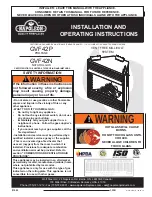
32
www.allmand.com
side. It is recommended that jack stands or blocking rated
for a minimum of 2 tons (1.8 t) be used to hold the trailer in
an elevated position when doing lengthy service procedures.
Elevate the heater trailer by positioning an appropriate jack
immediately behind the rear spring bracket. Elevate the
heater trailer only as high as necessary to accomplish the
intended task.
To elevate the heater trailer with a jack:
1. Place the heater trailer on a firm stable level surface that
will support the total weight of the trailer, and support the
force exerted on the ground by the jack.
2. Make sure the tongue jack quick release pin is properly
inserted in the locking hole. Use the tongue jack to level
the heater trailer front to back.
3. Chock both sides of the tire opposite of the side of the
heater trailer that you are intending to elevate.
4. Using a jack rated for a minimum of 2 tons (1.8 t), locate
a point immediately behind the rear spring bracket on the
side you intend to elevate. Raise the jack until it contacts
the bottom of the trailer. Then, elevate the trailer to the
necessary height.
5. Block the trailer in the elevated position with jack stands
or appropriate blocking.
NOTICE
Elevating the heater trailer by jacking or supporting it on
the axle or suspension could result in damage to the axle.
Always support the heater trailer by the chassis, and prefer-
ably on the ‘C’ channel running the length of the trailer in line
with the spring brackets and springs.
Servicing The Axle
The axle under the heater trailer will require periodic main-
tenance and service. Such things as brake adjustment,
inspection and replacement of brake linings and wheel bear-
ing adjustment and repacking will need to be accomplished
to maintain the axle. For information on the maintenance
schedule and servicing the axle, see the AL-KO Axle Owner’s
Manual.
Checking The Tire Pressure
Use a tire gauge to check the tire pressure; add or release air
as needed. See “Specifications” for correct cold tire inflation
pressure.
WARNING
Control Hazard
Towing a trailer with worn, damaged or underinflated tires
could result in death or serious injury. Always replace worn
or damaged tires promptly. Always keep tires inflated to
proper cold tire inflation pressure.
Maintaining The Battery
Removing the Battery
WARNING
Explosion Hazard
Be careful when handling the battery. Keep flames and
sparks away from the battery. When removing or installing
battery cables, disconnect the negative cable FIRST and
reconnect it LAST. If not done in this order, the positive ter-
minal can be shorted to the frame by a tool.
To remove the battery:
1. Disconnect the black negative (-) cable(s) from the nega-
tive (-) battery terminal, and secure away from the bat-
tery.
2. Disconnect the red positive (+) cable(s) from the positive
(+) battery terminal, and secure away from the battery.
3. Remove the hardware securing one side of each hold-
down bracket, and swing the brackets off to one side of
the battery.
4. Carefully remove the battery, and place in a well-ventilat-
ed area on a level surface.
To install the battery:
1. Carefully place the battery in the engine compartment
with the battery terminals toward the rear of the unit.
2. Install the battery hold-downs on top of the battery,
securing with the removed hardware. Tighten securely.
3. Connect the red positive (+) cable(s) to the positive (+)
battery terminal.
4. Connect the black negative (-) cable(s) to the negative (-)
battery terminal.
5. Replace the terminal covers over the battery terminals.
Cleaning the Battery and Cables
1. Remove the battery. See “Removing the Battery”.
2. Clean the battery terminals and cable ends with a wire
brush until shiny.
3. Reinstall the battery. See “Removing the Battery”.
4. Coat the cable ends and battery terminals with petroleum
jelly or non-conducting grease.
5. Be sure to replace the terminal covers over the battery
terminals.
Servicing the Battery
WARNING
Explosion Hazard
Keep open flames and sparks away from the battery; the
gasses coming from it are highly explosive. Ventilate the
battery well during charging.
Not
for
Reproduction
















































